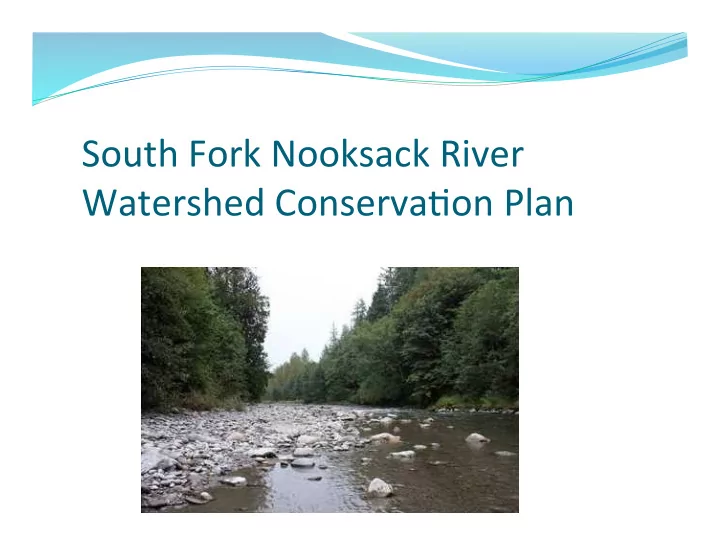

South Fork Nooksack River Watershed Conserva6on Plan
Why are we developing this Plan? Create a common understanding of watershed conditions, legacy impacts, and predicted climate change impacts on our watershed. Enable better coordination and prioritization of projects. Provide a foundation for dialogue and planning around watershed restoration in the South Fork Nooksack River Watershed.
Dra? Outline of the Conserva6on Plan 1. Executive Summary 2. Introduction 3. Watershed Characterization 4. Protection and Restoration Strategies (primary focus on water quality, quantity, fish, and habitat) 5. Future Planning Needs Ø Families, Farms, Forests, Recreation, etc.
This is a dra? for Watershed Group feedback! We want to know what you think of these ideas and strategies Your feedback will help us develop and refine this plan. Tonight, we will focus on specific areas of the Plan, and then finish writing it up We will send the whole document out when it is finished (hopefully) at the end of April Before another Watershed Group meeting, there will be plenty of time for your in-depth review – at least two weeks.
Watershed Characteriza6on Changes over time: Geology Legacy Impacts Climate Change Ø This is where we are going to focus most of our discussion tonight
Climate Change Projected future changes to the global climate system bring substantial risk to the watershed resources of the South Fork Nooksack River Watershed. Climate modeling studies are in general agreement that annual average surface air temperatures will likely rise on the order of 1 – 5 °C (about 2 – 9 °F) by 2100
Forecasted reduc6on of snowpack Average historical simulations indicate that winter snow dominates regions above 500-600 meters in the South Fork River basin, about 50% of the basin. As temperatures increase into the century, the average winter snowpack and snow-water equivalent will decrease and will be restricted to regions above 1000-1300 meters and cover Bob Mitchell about 20% or less of the basin.
Reduction of snow-water equivalent (SWE) in the South Fork basin due to future climate change historical basin average forecasted future basin average Bob Mitchell
Forecasted steamflow response in the South Fork due to future climate change Wickersham gauge higher winter flows due to rain rather than snow lower spring runoff due to less snow lower summer flows historical average flow Bob Mitchell
What does this mean for us? With more snow-free basin area exposed to rainfall, winter runoff increases, thus increasing the flood and mass-wasting risk during the wetter winter months. The projected decrease in snowpack also significantly reduces the spring runoff in the Nooksack River, meaning less water and warmer stream temperatures in the spring and summer. Bob Mitchell
Goals and Objec6ves The goals in this plan will align with the WRIA 1 Salmon Recovery Plan, Local Integrating Organization Plan, and the Watershed Management Plan
Community Long Range Goals For economic and ecological health of the watershed : families, farms, fish, forests, and recreation
Watershed Conserva6on Plan Summary of Watershed Resource Goals: Water quality: reduce temperature and sediment in streams Water quantity: meet instream flow requirements store water in the winter for release in summer Habitat restoration rebuild natural processes Salmon Recovery restore fish to harvestable levels
Salmon Recovery: EDT Habitat Model Results 30000 27,680 25000 20000 16,227 15000 Current Target: Target: Historic 10000 10,550* 7,604* 5000 2,723 1,215 0 North/Middle Fork Nooksack South Fork Nooksack Early Early Chinook Chinook *Assumes a population growth rate of 3.1 (returning spawners per spawning fish)
Strategies Floodplain Restoration Continue instream restoration projects in high 1. priority reaches of the South Fork that create cold- water refuges and habitat. 2. Work with landowners to explore lower-cost instream projects along the river channel 3. Examine feasibility of improving passage in constricted areas (i.e. railroad/road constriction) 4. Work with landowners to identify opportunities for floodwater storage and floodplain reconnection
Strategies Riparian Restoration Continue to implement and expand the Conservation Reserve Enhancement (CREP) program through the lower South Fork and seek funding to extend 15-year lease terms and/or otherwise work to protect existing CREP buffers over the long-term. Support willing landowners to do more riparian protection and restoration along the lower South Fork, and focus funding resources on areas of greatest ecological lift.
Strategies Uplands Restoration Work with forest landowners to study and explore the feasibility of silvicultural practices that optimize snow storage duration and maximize soil moisture. Practices could include: Retain and protect forests in wind-exposed areas Gap cutting or thinning Extend harvest rotations to allow maturation of selected stands
Strategies Wetlands Restoration Work with willing landowners to protect and restore high priority wetlands along the lower South Fork, with the goal of maximizing: Temperature maintenance, Base flow maintenance, Sediment retention/transformation, and Flood flow storage and desynchronization.
Strategies Beaver re-introduction and re-location Rationale: Beaver ponds can have profound impacts on a watershed’s potential for water retention. Active dams retain water in the dry season, metering it out downstream through gaps in the semi- permeable dam wall. Beaver dams can substantially reduce stream temperatures, trap sediment, and provide habitat for salmon Strategy: Work with landowners to identify locations where it would be beneficial to introduce or relocate beaver dams
Strategies Water Banking Develop a groundwater-flow model coupled with a watershed model for the South Fork basin to prioritize habitat restoration projects. Assess water rights, incentivize water conservation, identify opportunities to restore stream flow as well as utilizing tools to address water needs (change/ transfer of water rights, water banking, etc.) in voluntary projects.
Next Steps • Watershed Conservation Plan to be completed • Draft will be released to everyone at the same time • Deadlines for comments - @2 weeks after release (is this enough time?) • Within the next few months (depending on how much feedback) the Tribe would then have a final draft ready to share (through email to stakeholders and via website) • In addition to a Watershed Group Meeting - should we have a Community Meeting to present the final document?
Thank you!
Recommend
More recommend